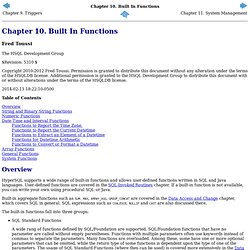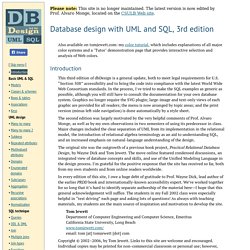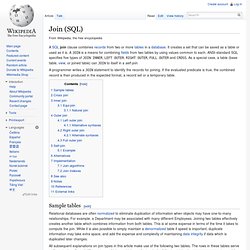

Chapter 9. SQL Syntax. HSQLDB version 1.8.0 supports the SQL statements and syntax described in this chapter.

ALTER INDEX <indexname> RENAME TO <newname>; Index names can be changed so long as they do not conflict with other user-defined or sytem-defined names. ALTER SEQUENCE <sequencename> RESTART WITH <value>; Resets the next value to be returned from the sequence. ALTER SCHEMA <schemaname> RENAME TO <newname>; Renames the schema as specified. Requires Administrative privileges. ALTER TABLE <tablename> ADD [COLUMN] <columnname> Datatype [(columnSize[,precision])] [{DEFAULT <defaultValue> | GENERATED BY DEFAULT AS IDENTITY (START WITH <n>[, INCREMENT BY <m>])}] | [[NOT] NULL] [IDENTITY] [PRIMARY KEY] [BEFORE <existingcolumn>]; Adds the column to the end of the column list.
Chapter 10. Built In Functions. Chapter 10.

Built In Functions Fred Toussi The HSQL Development Group. SQL Tutorial. Version 4.71 This page is a introductory tutorial of the Structured Query Language (also known as SQL) and is a pioneering effort on the World Wide Web, as this is the first comprehensive SQL tutorial available on the Internet.

SQL allows users to access data in relational database management systems, such as Oracle, Sybase, Informix, Microsoft SQL Server, Access, and others, by allowing users to describe the data the user wishes to see. SQL also allows users to define the data in a database, and manipulate that data. This page will describe how to use SQL, and give examples. The SQL used in this document is "ANSI", or standard SQL, and no SQL features of specific database management systems will be discussed until the "Nonstandard SQL" section. Also, you may be interested in joining the new SQL Club on Yahoo! Table of Contents Basics of the SELECT Statement.
SQL Tutorial. SQL - Date Functions. Following is a list of all important Date and Time related functions available through SQL.

There are various other functions supported by your RDBMS. Given list is based on MySQL RDBMS. ADDDATE(date,INTERVAL expr unit), ADDDATE(expr,days) When invoked with the INTERVAL form of the second argument, ADDDATE() is a synonym for DATE_ADD(). The related function SUBDATE() is a synonym for DATE_SUB(). When invoked with the days form of the second argument, MySQL treats it as an integer number of days to be added to expr. mysql> SELECT ADDDATE('1998-01-02', 31);+---------------------------------------------------------+| DATE_ADD('1998-01-02', INTERVAL 31 DAY) |+---------------------------------------------------------+| 1998-02-02 |+---------------------------------------------------------+1 row in set (0.00 sec) ADDTIME(expr1,expr2) ADDTIME() adds expr2 to expr1 and returns the result. expr1 is a time or datetime expression, and expr2 is a time expression. CONVERT_TZ(dt,from_tz,to_tz) Composite Primary Keys. Ah … primary keys … such a topic!

When discussing what columns to define as a primary key in your data models, two large points always tend to surface: These can be very complicated and sometimes polarizing things to debate. As I often try to do, I will attempt to approach this topic from a slightly different perspective. Let's start things off with what I feel is a good interview question: How would you define what a primary key of a table is? Database Design - Introduction. Please note: This site is no longer maintained.

The latest version is now edited by Prof. Alvaro Monge, located on the CSULB Web site. This third edition of dbDesign is a general update, both to meet legal requirements for U.S. “Section 508” accessibility and to bring the code into compliance with the latest World Wide Web Consortium standards. In the process, I've tried to make the SQL examples as generic as possible, although you will still have to consult the documentation for your own database system.
The second edition was largely motivated by the very helpful comments of Prof. The original site was the outgrowth of a previous book project, Practical Relational Database Design, by Wayne Dick and Tom Jewett. In every edition of this site, I owe a huge debt of gratitude to Prof. Copyright © 2002–2006, by Tom Jewett. Join (SQL) A programmer writes a JOIN statement to identify the records for joining.

If the evaluated predicate is true, the combined record is then produced in the expected format, a record set or a temporary table. Relational databases are often normalized to eliminate duplication of information when objects may have one-to-many relationships. For example, a Department may be associated with many different Employees. Joining two tables effectively creates another table which combines information from both tables.
This is at some expense in terms of the time it takes to compute the join. Note: In the Employee table above, the employee "John" has not been assigned to any department yet. Index of /jmisiak/SQLDoPobrania/manuale. SQLZOO. SQL-99 Complete, Really - AskMonty KnowledgeBase.